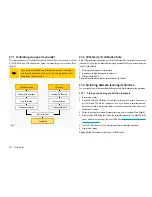
14
| Safety Instructions
>
Leaking or damaged batteries can cause acid burns when in contact with skin.
Therefore use suitable protective gloves to handle corrupted and leaking batteries.
>
Batteries must be kept out of the reach of children. Do not leave the batteries lying
around. There is a risk that children or pets may swallow them.
>
All batteries should be replaced at the same time. Mixing old and new batteries can
lead to battery leakage and device damage.
>
Batteries must not be dismantled, short-circuited or exposed to fire. Never recharge
non-rechargeable batteries. There is a risk of explosion!
>
Never mix regular batteries and rechargeable batteries!
15.5.2 LiPo batteries
After the flight, the LiPo flight battery must be disconnected
from the »NovaX 350.
Lithium is a highly reactive chemical element with a
high energy density. In the case of overcharging, the
LiPo rechargeable battery packs might catch fire or even
explode. Therefore, LiPo rechargeable battery packs must
always be put on a fire-proof surface for charging and the
charging process must be supervised.
In no case must the maximum permissible battery
pack temperature of +60°C be exceeded Otherwise the
rechargeable battery may explode!
15.5.2.1 Hazards of LiPo flight batteries
>
Do not leave the LiPo flight battery connected when you do not use it (e.g. during
transport or storage). Otherwise, the LiPo flight battery may be fully discharged. This
would destroy it and render it unusable! There is also a danger of malfunction due to
interference. The rotors could start up inadvertently and cause damage or injury.
>
Rechargeable LiPo batteries are very susceptible to moisture due to the chemicals they
contain! Do not expose them to moisture or liquids. Risk of explosion!
>
Do not expose the charger or LiPo flight battery to high/low temperatures or to direct
solar radiation. When handling LiPo batteries, observe the special safety information
of the battery manufacturer!
>
Never charge the LiPo flight battery immediately after use. Always leave the LiPo flight
battery to cool off first (at least 5-10 minutes).
>
Only charge intact and undamaged batteries. If the external insulation of the
rechargeable battery is damaged or if the rechargeable battery is deformed or bloated,
it must not be charged. In this case, there is immediate danger of fire and explosion!
>
Never damage the exterior of a LiPo flight battery. Never cut the covering foil. Never
stab any LiPo flight batteries with pointed objects.
>
As the charger and the rechargeable LiPo flight battery both heat up during the
charging procedure, it is necessary to ensure sufficient ventilation. Never cover the
charger or the LiPo flight battery! Of course, this also applies for all other chargers and
rechargeable batteries.
>
Remove the LiPo flight battery that is to be charged from the model and place it on a
fire-proof support (e.g. a plate). Keep a distance to flammable objects.
>
Disconnect the LiPo flight battery from the charger when it is fully charged.
>
Chargers may only be operated in dry rooms. The charger and the LiPo flight battery
must not become damp or wet.
>
Never take the rechargeable battery apart! The rechargeable battery may not be
subjected to any mechanical strain!
>
The contacts may not be short-circuited, as there is danger of fire and explosion!
Summary of Contents for NovaX 350
Page 1: ...88012RC ArF 88014RC RtF NovaX 350 Operating instructions M1...
Page 2: ...2 EVER WONDERED WHAT INNOVATION LOOKS LIKE NovaX 350...
Page 21: ...Dimensions 21 22 2 Long legs 283 mm 283 mm 250 mm 241 mm 130 mm 2 0 3 m m 3 4 7 m m...
Page 27: ...Calibration 27 2 1 90 90 90 1 2 3 4 5 6 Fig 6...
Page 49: ...49...
Page 50: ...50...
Page 51: ...51...
Page 52: ...52 www rclogger com...












































